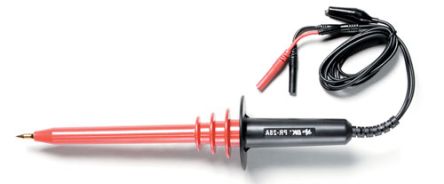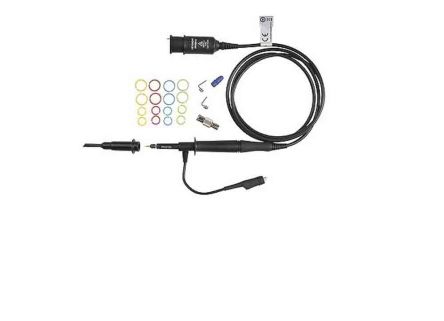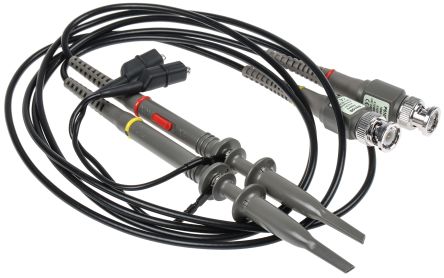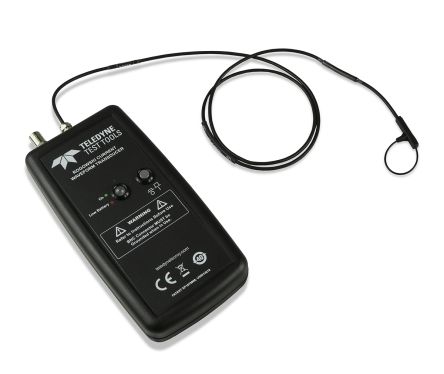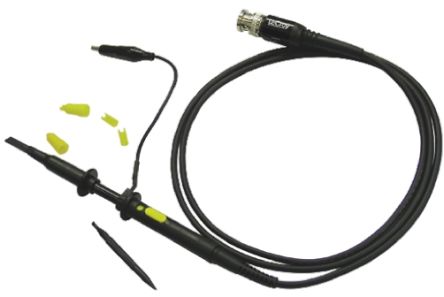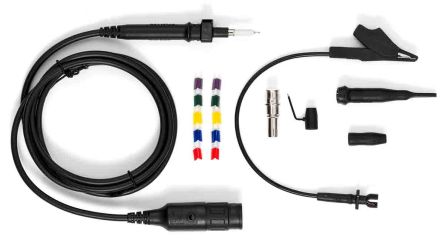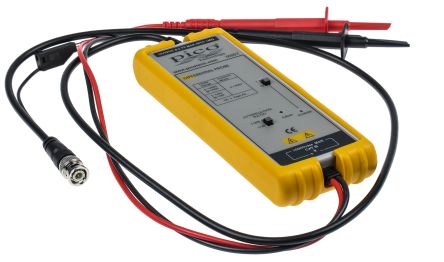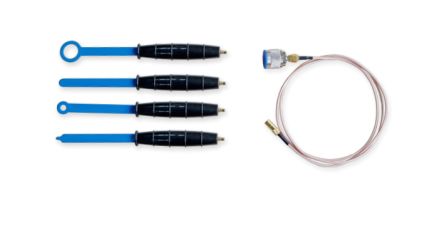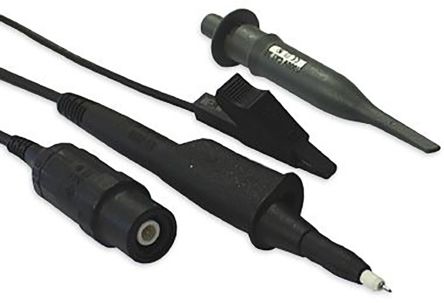- Automation & Control Gear
- Cables & Wires
- Enclosures & Server Racks
- Fuses & Circuit Breakers
- HVAC, Fans & Thermal Management
- Lighting
- Relays & Signal Conditioning
- Switches
- Batteries & Chargers
- Connectors
- Displays & Optoelectronics
- ESD Control, Cleanroom & PCB Prototyping
- Passive Components
- Power Supplies & Transformers
- Raspberry Pi, Arduino, ROCK, STEM Education & Development Tools
- Semiconductors
Oscilloscope Probes
สายวัดออสซิลโลสโคป (Oscilloscope Probe)
สายโพรบออสซิลโลสโคป (Oscilloscope Probes) เป็นอุปกรณ์ชนิดหนึ่งที่วิศวกรไฟฟ้านิยมใช้กันโดยทั่วไป มีคุณสมบัติในการวัดสัญญาณไฟฟ้า และแสดงออกมาในรูปแบบกราฟแนวตั้ง (แกน X) และกราฟแนวนอน (แกน Y) สายวัดออสซิลโลสโคปสามารถนำไปใช้ร่วมกับอุปกรณ์อิเล็กทรอนิกส์ต่าง ๆ ได้หลากหลาย ช่วยให้การตรวจสอบสัญญาณไฟฟ้ากลายเป็นเรื่องง่ายและรวดเร็วยิ่งขึ้น
การซื้อสายออสซิลโลสโคป ต้องพิจารณาจากอะไรบ้าง ?
- ตรวจสอบให้แน่ใจว่าหัว Oscilloscope Probes สามารถเชื่อมต่อเข้ากับอุปกรณ์อิเล็กทรอนิกส์ของคุณได้
- เลือกหัววัด Oscilloscope ที่สามารถรองรับสัญญาณไฟฟ้าในระดับที่ต้องการได้ เพราะการจับคู่สัญญาณที่ถูกต้อง จะช่วยให้สามารถถ่ายทอดกราฟสัญญาณไฟฟ้าออกมาได้อย่างแม่นยำ
ออสซิลโลสโคปโพรบ มีกี่ประเภท ?
ออสซิลโลสโคปโพรบ สามารถแบ่งออกได้เป็น 4 ประเภทหลักดังนี้
โพรบพาสซีฟออสซิลโลสโคป
เป็นโพรบที่ใช้กันทั่วไปในการวัดสัญญาณไฟฟ้า มีจุดเด่นที่สามารถใช้งานง่าย ราคาย่อมเยา และมีความแข็งแรงทนทาน มีให้เลือก 4 รูปแบบดังนี้
- 1x : ไม่มีการลดทอนสัญญาณไฟฟ้า
- 10x : สามารถลดทอนสัญญาณไฟฟ้าได้ 10 เท่า
- 100x : สามารถลดทอนสัญญาณไฟฟ้าได้ 100 เท่า
- 1000x : สามารถลดทอนสัญญาณไฟฟ้าได้ 1,000 เท่า ช่วยให้สามารถวัดสัญญาณไฟฟ้าที่อาจเกินขีดจำกัดของหัว Oscilloscope Probes และสามารถใช้วัดคลื่นไฟฟ้าความถี่สูงได้
โพรบแอคทีฟออสซิลโลสโคป
โพรบแอคทีฟออสซิลโลสโคป มาพร้อมกับเครื่องขยายสัญญาณในที่ช่วยเพิ่มประสิทธิภาพในการตรวจวัด จึงเหมาะกับการวัดสัญญาณที่มีความถี่สูง ตั้งแต่ 500 MHz ขึ้นไป เช่น สัญญาณดิจิทัลความเร็วสูง
โพรบดิฟเฟอเรนเชียล
โพรบดิฟเฟอเรนเชียล ใช้วัดค่าต่างศักย์ไฟฟ้าระหว่างสองจุดในวงจร มีประโยชน์อย่างยิ่งในการวัดสัญญาณไฟฟ้าแรงดันสูง หรือวงจรไฟฟ้าแบบเดินลอย
โพรบวัดกระแสไฟฟ้า
โพรบวัดกระแสไฟฟ้า ทำหน้าที่วัดกระแสไฟฟ้าที่ไหลผ่านตัวนำ ใช้งานโดยการนำโพรบไปหนีบรอบสายไฟหรือสายเคเบิล โดยไม่ต้องตัดวงจร
โพรบแรงดันสูง
โพรบแรงดันสูง เป็นโพรบพาสซีฟชนิดพิเศษ ออกแบบมาเพื่อวัดสัญญาณแรงดันสูง ซึ่งเกินค่ามาตรฐานที่โพรบทั่วไปสามารถวัดได้ เหมาะกับการทดสอบอุปกรณ์ที่ทำงานภายใต้ไฟฟ้าแรงดันสูง เช่น อุปกรณ์จ่ายไฟ และเครื่องจักรอุตสาหกรรม
เคล็ดลับในการใช้งานสายออสซิลโลสโคปให้มีประสิทธิภาพ
- เลือกหัววัด Oscilloscope ให้เหมาะกับอุปกรณ์อิเล็กทรอนิกส์ที่ต้องการนำไปใช้เสมอ
- เลือกความยาวของสาย Probe Oscilloscope ให้เหมาะสม ไม่ควรยาวเกินไป เพราะอาจส่งผลต่อความแม่นยำในการวัด
ตัวอย่างการใช้งานออสซิลโลสโคปโพรบในอุตสาหกรรมต่าง ๆ
สายโพรบออสซิลโลสโคป เป็นเครื่องมือที่สำคัญอย่างยิ่งในการวัดและวิเคราะห์สัญญาณไฟฟ้าในอุตสาหกรรมต่าง ๆ การเลือกใช้โพรบที่เหมาะสม จะช่วยให้ได้ผลการวัดที่แม่นยำมากที่สุด มาดูกันว่า เราสามารถนำสาย Probe Oscilloscope ไปใช้งานในอุตสาหกรรมใดได้บ้าง
อุตสาหกรรมอิเล็กทรอนิกส์
- การออกแบบวงจร : ใช้ในการตรวจสอบและแก้ไขปัญหาในวงจรอิเล็กทรอนิกส์ เช่น วงจรดิจิทัล วงจรแอนะล็อก และวงจรแบบผสม
- การทดสอบอุปกรณ์ : ใช้ในการทดสอบประสิทธิภาพของอุปกรณ์อิเล็กทรอนิกส์ต่าง ๆ เช่น IC, ทรานซิสเตอร์ และแอมป์
- การพัฒนาไมโครคอนโทรลเลอร์ : ใช้ในการทดสอบไมโครคอนโทรลเลอร์ (Microcontroller) หรือ อุปกรณ์ควบคุมขนาดเล็ก ที่ใช้กันในระบบคอมพิวเตอร์
อุตสาหกรรมยานยนต์
- การพัฒนาระบบอิเล็กทรอนิกส์ในรถยนต์ : ใช้ในการวัดสัญญาณจากเซ็นเซอร์ต่าง ๆ เช่น เซ็นเซอร์วัดความเร็วรอบเครื่องยนต์ หรือ เซ็นเซอร์ตำแหน่งเพลา
- การวินิจฉัยปัญหา : ใช้หาสาเหตุของปัญหาในระบบไฟฟ้าของรถยนต์ เช่น ปัญหาในการสตาร์ตเครื่องยนต์, ปัญหาในการทำงานของระบบ ABS และปัญหาในการทำงานของระบบควบคุมความเร็วอัตโนมัติ
อุตสาหกรรมการสื่อสาร
- การทดสอบสัญญาณ : ใช้ในการวัดคุณภาพของสัญญาณโทรคมนาคม เช่น สัญญาณ RF, สัญญาณดิจิทัล และสัญญาณแอนะล็อก
- การพัฒนาระบบสื่อสาร : ใช้ในการพัฒนาและทดสอบอุปกรณ์สื่อสารต่าง ๆ เช่น โมเด็ม, เราเตอร์ และสวิตช์
อุตสาหกรรมการผลิต
- การควบคุมคุณภาพ : ใช้ในการตรวจสอบคุณภาพของผลิตภัณฑ์อิเล็กทรอนิกส์ เช่น ตรวจสอบการเชื่อมต่อไฟฟ้า หรือตรวจสอบการทำงานของวงจรไฟฟ้า
- การบำรุงรักษา : ใช้ตรวจสอบและแก้ไขปัญหาในเครื่องจักรและอุปกรณ์ที่ใช้ระบบควบคุมอิเล็กทรอนิกส์ เพื่อให้อุปกรณ์ต่าง ๆ ทำงานได้อย่างมีประสิทธิภาพและปลอดภัยอยู่เสมอ
RS จำหน่ายหัววัด Oscilloscope จากแบรนด์ชั้นนำที่คุณมั่นใจ ช็อปสะดวกทางออนไลน์
RS ผู้นำด้านโซลูชันอุตสาหกรรมและอิเล็กทรอนิกส์ จำหน่ายสายโพรบออสซิลโลสโคป สายวัดออสซิลโลสโคป จากแบรนด์ชั้นนำที่ผ่านการรับรองด้านความปลอดภัย ตอบโจทย์ทุกการใช้งาน เช่น Teledyne LeCroy, Keysight Technologies, Rohde & Schwarz และแบรนด์ของเราเองอย่าง RS PRO โดยเราจำหน่ายสายโพรบออสซิลโลสโคปทั้งราคาปลีกและราคาส่ง สามารถเลือกซื้อสายออสซิลโลสโคปที่ต้องการได้อย่างสะดวกตลอด 24 ชม. บนเว็บไซต์ พร้อมบริการจัดส่งทั่วประเทศไทย หรือปรึกษาผู้เชี่ยวชาญด้านผลิตภัณฑ์ เพื่อขอรับคำแนะนำเกี่ยวกับการเลือกสาย BNC ออสซิลโลสโคปให้เหมาะกับการใช้งานในอุตสาหกรรมของคุณได้เลย



